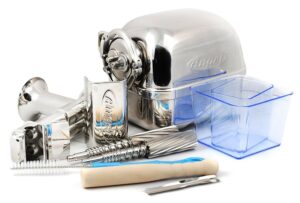When it comes to equipping your kitchen, a blender is often a cornerstone appliance that can significantly enhance your culinary adventures. From making smoothies and soups to pureeing sauces and crushing ice, blenders offer versatility that can meet a variety of kitchen needs. However, with so many options available on the market, choosing the right blender can be a daunting task. In this guide, we will walk you through the key factors to consider when selecting the perfect blender for your kitchen.
Understanding the Different Types of Blenders
Countertop Blenders
Countertop blenders are the most common type of blender found in kitchens. These versatile appliances are suitable for a wide range of tasks, including making smoothies, soups, and sauces. They typically feature a powerful motor and various speed settings to handle different ingredients.
Personal Blenders
Personal blenders are designed for single servings and are perfect for those who need quick, on-the-go options. They are compact, easy to store, and usually come with travel-friendly blending cups. While they may not be as powerful as countertop blenders, they are ideal for smoothies and small batches.
Immersion Blenders
Also known as hand blenders or stick blenders, immersion blenders are handheld devices that you can immerse directly into a pot, bowl, or cup. They are excellent for blending soups, sauces, and even small quantities of batter. Immersion blenders are easy to clean and store, making them a convenient option for quick tasks.
High-Performance Blenders
High-performance blenders are built for heavy-duty use and can handle tough ingredients like nuts, seeds, and ice with ease. These blenders usually come with more powerful motors and advanced blade designs, allowing them to create smoother textures and emulsify mixtures. They are often more expensive but are ideal for those who need a robust, multifunctional appliance.
Specialty Blenders
Specialty blenders are designed for specific tasks, such as making frozen desserts, juicing, or grinding grains. These blenders often come with unique attachments or settings tailored to their specialized functions. If you have a particular culinary need, a specialty blender might be the right choice for you.
Evaluating Industrial Blender Power and Performance
When evaluating the power and performance of an industrial blender, one of the first aspects to consider is the motor’s wattage. Blenders typically range from 300 watts for basic models to over 1,500 watts for high-performance machines. Higher wattage usually translates to more robust blending capabilities, making it easier to tackle tough ingredients like ice, nuts, and fibrous vegetables. Another critical factor is the speed settings.
Some blenders come with pre-programmed settings for specific tasks such as smoothies, soups, and ice crushing. Variable speed settings allow you to control the blending process more precisely, giving you the flexibility to achieve the desired texture for different recipes.
Pulse functions are also beneficial for giving short bursts of power, ideal for chopping ingredients or breaking down larger pieces. The blade assembly significantly impacts performance as well. Look for blenders with sturdy, sharp blades made from stainless steel. Some high-performance blenders feature multi-tier blade designs that can blend more efficiently, creating smoother textures and thoroughly mixing ingredients.
Overload protection is another feature worth considering. This function helps protect the motor from overheating by automatically shutting off the blender when it is overworked, thereby extending the appliance’s lifespan. Lastly, consider the noise level. Powerful blenders tend to be louder, but some models are designed with noise-reducing technology to make the blending process quieter and more pleasant. Evaluating these factors will ensure that you choose a blender that meets your power and performance needs.
Considering the Blender Jar Material and Capacity
When selecting a blender, the jar material and capacity are crucial elements to consider. Blender jars typically come in three materials: glass, plastic, and stainless steel. Each material has its advantages and drawbacks. Glass jars are known for their durability and ability to resist odors and stains, making them an excellent long-term investment.
However, they are heavier and can break if dropped. Plastic jars, on the other hand, are lightweight and shatterproof, offering convenience and safety. The downside is that they can scratch easily and might retain odors over time. Stainless steel jars are incredibly durable and ideal for hot liquids, but they do not allow you to see the blending process, which can be a drawback for some users.
Regarding capacity, blender jars typically range from 32 ounces to 64 ounces or more. If you frequently prepare large batches of smoothies, soups, or sauces, a larger jar will save you time and effort. Conversely, if you usually blend single servings or small quantities, a smaller jar will be more practical and easier to manage. Choosing the right jar material and capacity ensures that your blender will meet your specific culinary needs and preferences.
Examining Blade Quality and Design of Commercial Blender
When it comes to the effectiveness of a commercial blender, the quality and design of its blades are paramount. High-quality blades are typically made from stainless steel, known for its durability and resistance to corrosion. Stainless steel blades maintain sharpness over time, ensuring consistent performance even with frequent use.
The design of the blades also plays a crucial role in blending efficiency. Look for blenders that feature multi-tier or multi-angle blade designs. These blades can create a vortex that pulls ingredients downwards for a more thorough blend, minimizing the need for manual stirring.
Serrated or jagged blades are particularly effective for tackling tough ingredients like ice and fibrous vegetables, providing smoother results. Another aspect to consider is the ease of blade removal. Blades that can be easily detached make cleaning safer and more convenient. Some commercial blenders also offer blade assemblies that are dishwasher-safe, simplifying maintenance.
Additionally, advanced blade technologies, such as blades with specially coated surfaces, can enhance performance by reducing friction and improving blending speed. Some high-performance commercial blenders incorporate blade assemblies with cooling systems to prevent overheating during extended use. Overall, understanding the blade quality and design will help you select a commercial blender that delivers superior performance and longevity, catering to your diverse culinary needs.
Reviewing Ease of Use and Cleaning
When it comes to ease of use, look for blenders with straightforward, intuitive controls. Models with labeled buttons and clear speed settings simplify the blending process, making them accessible for users of all skill levels. Some advanced blenders even offer touchscreens or smart technology that can automatically adjust settings based on the ingredients you’re using. Cleaning a blender can often be a hassle, so choosing a model that offers easy maintenance is crucial.
Many modern blenders come with self-cleaning functions: simply add water and a drop of dish soap, run the blender for a few seconds, and rinse. Removable blades are another feature to look for, as they make it easier to clean the nooks and crannies where food particles can get trapped. Dishwasher-safe components, such as jars, lids, and blade assemblies, can save you a lot of time and effort.
Blenders with fewer parts are generally easier to clean, reducing the risk of losing small pieces or spending too much time on disassembly and reassembly. Some models even offer specially designed cleaning brushes that fit perfectly into tight spaces, ensuring thorough cleaning. In summary, selecting a blender with user-friendly features and easy-to-clean components can make your culinary experience much more enjoyable.
Budget Considerations for the Blender
Entry-Level Blenders
Entry-level blenders typically range from $30 to $100 and are suitable for basic tasks like making smoothies and light purees. These blenders usually come with lower wattage motors and may have fewer speed settings. While they might not handle tough ingredients well, they are a budget-friendly option for occasional use.
Mid-Range Blenders
Mid-range blenders, costing between $100 and $300, offer a balance of performance and affordability. They often feature more powerful motors, better blade designs, and additional settings. These blenders are capable of handling a wider range of tasks, from crushing ice to making nut butters, making them a great choice for everyday use.
High-End Blenders
High-end blenders are priced upwards of $300 and are designed for serious home cooks and culinary enthusiasts. They boast high-performance motors, advanced blade assemblies, and multiple pre-programmed settings. These blenders offer exceptional durability and can handle tough ingredients with ease. Investing in a high-end blender can be worthwhile if you require robust performance and versatility.
Refurbished or Second-Hand Blenders
For those on a tight budget, refurbished or second-hand blenders can be a viable option. These blenders are often restored to near-new condition and sold at a fraction of the cost. However, make sure to buy from reputable sellers and check for any warranties or return policies to ensure you’re getting a reliable appliance.
Reading Customer Reviews and Ratings for the Best Blender
Customer reviews and ratings are essential tools for gauging the real-world performance and reliability of the best blender. Start by browsing through reviews on trusted retail websites, where verified buyers share their experiences with specific models. Focus on detailed reviews that discuss both the pros and cons, as these provide a balanced perspective.
Additionally, kitchen appliance forums can offer valuable insights, as members often share in-depth reviews and practical tips based on long-term usage. Pay close attention to comments about the blender’s durability, ease of cleaning, and customer service experiences.
Expert reviews from kitchen appliance websites and cooking shows can also be very informative. These reviews often include rigorous testing and comparisons across different models, highlighting key features and performance metrics. Combining insights from both customer and expert reviews can help you make a well-informed decision, ensuring you choose a blender that best meets your kitchen needs and expectations.
Conclusion
Choosing blenders that fit your kitchen needs involves evaluating several crucial factors. First, consider the different types of blenders available: countertop, personal, immersion, high-performance, and specialty blenders. Each type offers unique advantages tailored to specific culinary tasks, from everyday smoothies to specialized recipes. Next, pay close attention to power and performance aspects such as motor wattage, speed settings, and blade design. These elements significantly impact the blender’s ability to handle various ingredients and achieve the desired textures. Don’t overlook the importance of jar material and capacity, as they can affect both durability and convenience in your kitchen routines.
3 FAQs
What is the difference between a regular blender and high-performance blenders?
A high-performance blender generally features a more powerful motor and advanced blade design, enabling it to tackle tougher ingredients like nuts and ice more efficiently. In contrast, regular blenders are better suited for simpler tasks such as making smoothies and light purees.
Can I blend hot liquids in my blender?
Yes, most blenders can handle hot liquids, but it’s crucial to consult the manufacturer’s guidelines. Some models come equipped with vented lids specifically designed to blend hot ingredients safely, preventing pressure buildup and spills.
How often should I replace my blender?
The lifespan of a blender varies depending on usage and quality. Typically, a good-quality blender should last several years with proper care. Signs that it might be time for a replacement include decreased performance, unusual noises, or visible wear and tear.



